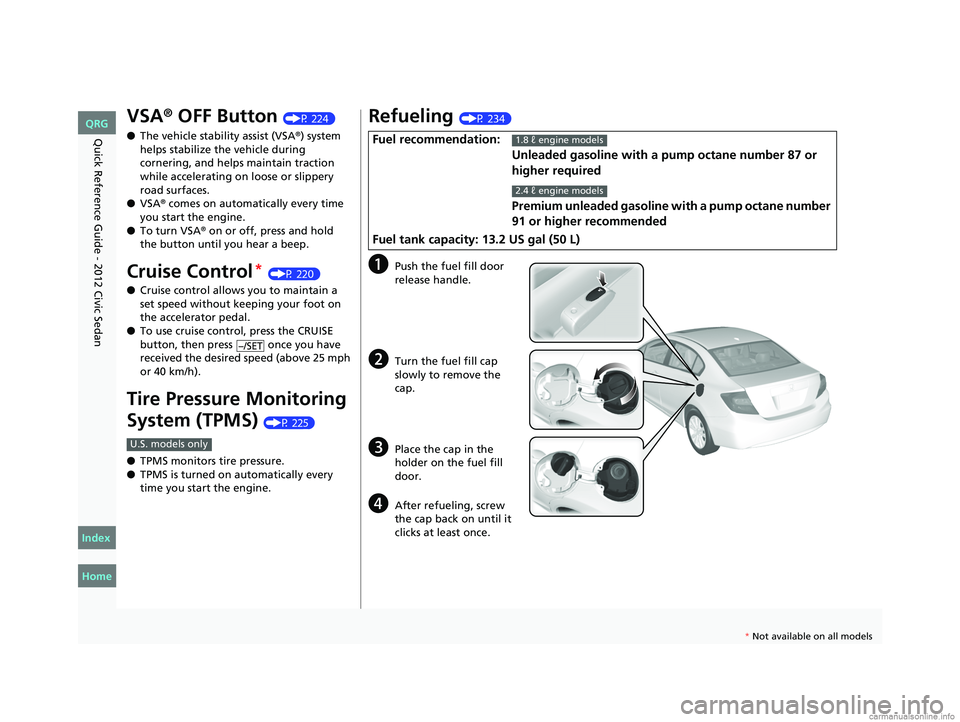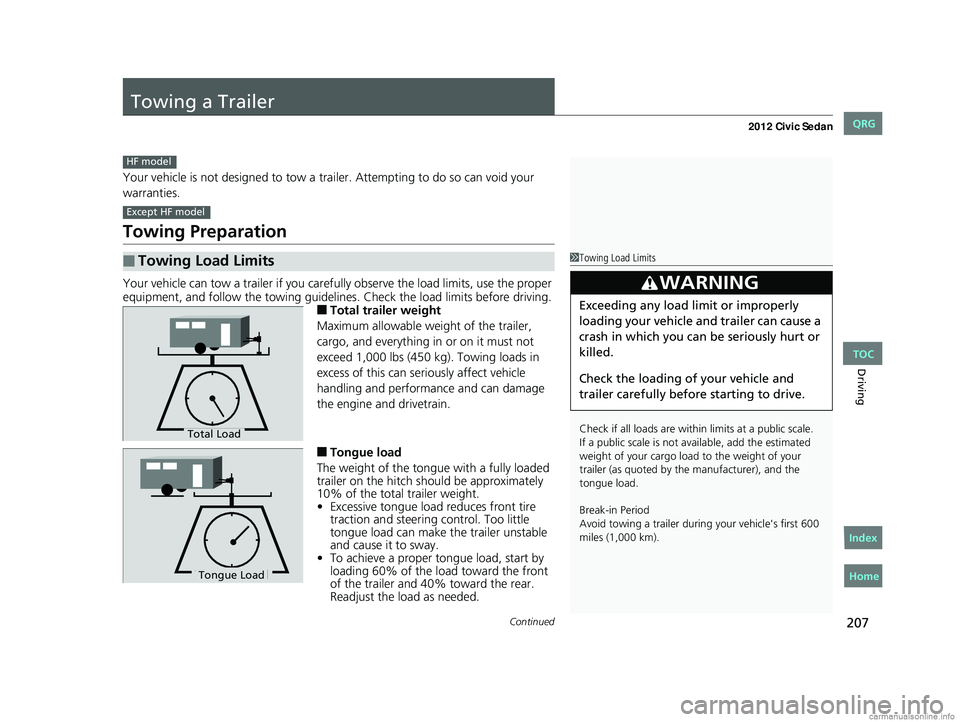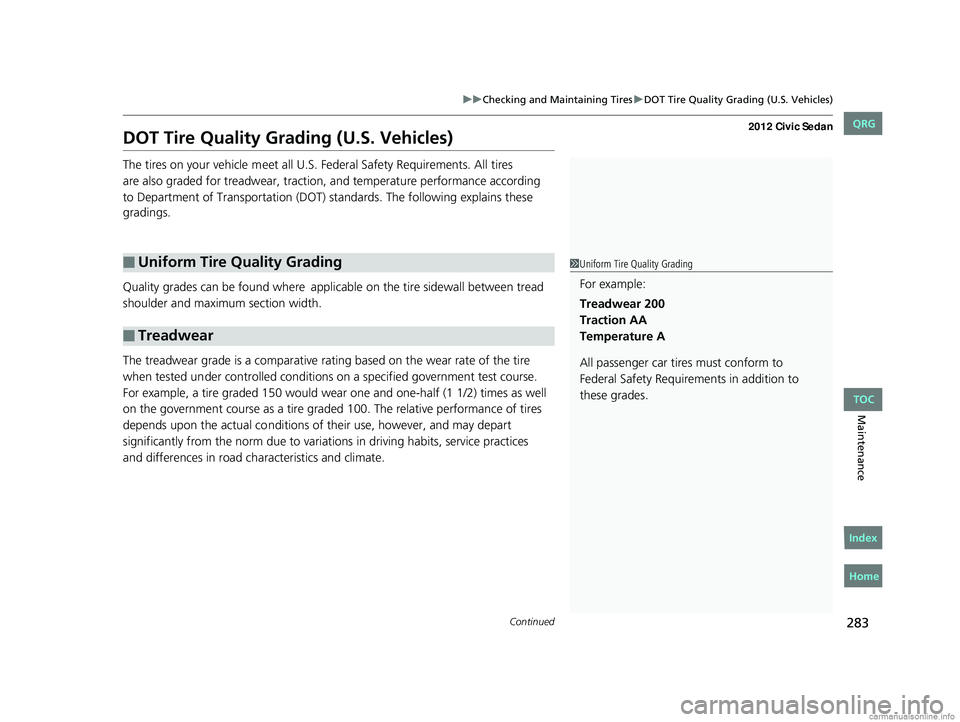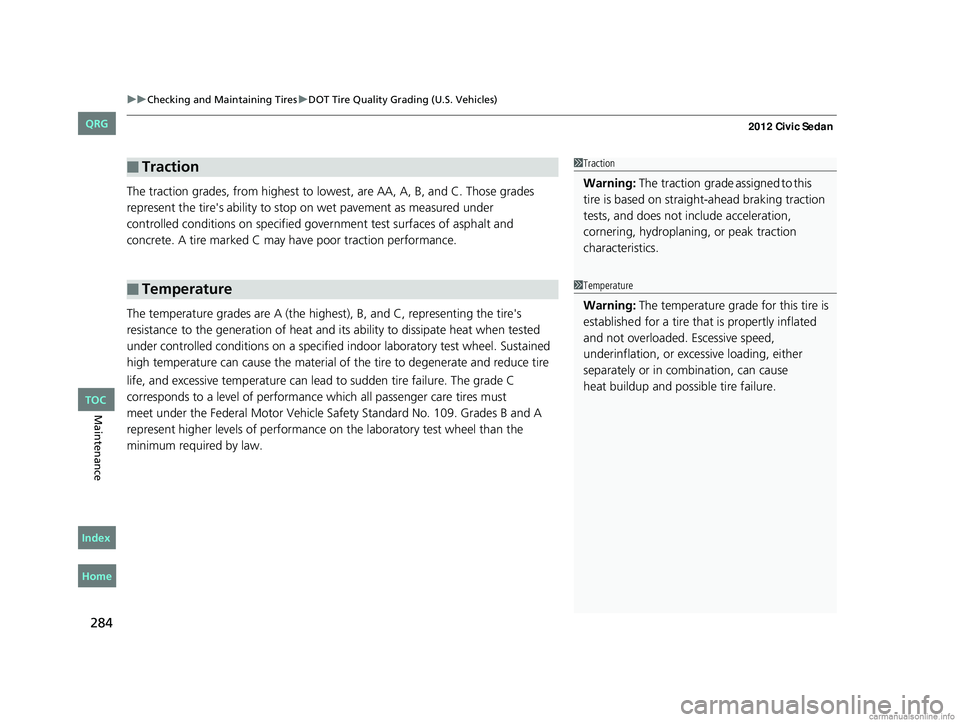2012 HONDA CIVIC SEDAN traction control
[x] Cancel search: traction controlPage 17 of 345

16
Quick Reference Guide - 2012 Civic Sedan
VSA® OFF Button (P 224)
● The vehicle stability assist (VSA
®) system
helps stabilize the vehicle during
cornering, and helps maintain traction
while accelerating on loose or slippery
road surfaces.
● VSA
® comes on automatically every time
you start the engine.
● To turn VSA
® on or off, press and hold
the button until you hear a beep.
Cruise Control* (P 220)
● Cruise control allows you to maintain a
set speed without keeping your foot on
the accelerator pedal.
● To use cruise control, press the CRUISE
button, then press once you have
received the desired speed (above 25 mph
or 40 km/h).
Tire Pressure Monitoring
System (TPMS)
(P 225)
● TPMS monitors tire pressure.
● TPMS is turned on automatically every
time you start the engine.
–/SET
U.S. models only
Refueling (P 234)
aPush the fuel fill door
release handle.
bTurn the fuel fill cap
slowly to remove the
cap.
cPlace the cap in the
holder on the fuel fill
door.
dAfter refueling, screw
the cap back on until it
clicks at least once.
Fuel recommendation:
Unleaded gasoline with a pu mp octane number 87 or
higher required
Premium unleaded gasoline wi th a pump octane number
91 or higher recommended
Fuel tank capacity: 13.2 US gal (50 L)1.8 ℓ engine models
2.4 ℓ engine models
CIVIC 4D-31TR3600.book 16 ページ 2011年2月14日 月曜日 午後2時51分
Home
QRG
Index
* No t avai lable on all m odel s
Page 208 of 345

207Continued
Driving
Towing a Trailer
Your vehicle is not designed to tow a trailer. Attempting to do so can void your
warranties.
Towing Preparation
Your vehicle can tow a trailer if you carefully observe the load limits, use the proper
equipment, and follow the towing guidelin es. Check the load limits before driving.
■Total trailer weight
Maximum allowable weight of the trailer,
cargo, and everything in or on it must not
exceed 1,000 lbs (450 kg). Towing loads in
excess of this can seriously affect vehicle
handling and performance and can damage
the engine and drivetrain.
■Tongue load
The weight of the tongue with a fully loaded
trailer on the hitch should be approximately
10% of the total trailer weight.
• Excessive tongue load reduces front tire
traction and steering control. Too little
tongue load can make the trailer unstable
and cause it to sway.
• To achieve a proper tongue load, start by
loading 60% of the load toward the front
of the trailer and 40% toward the rear.
Readjust the lo ad as needed.
■Towing Load Limits
HF model
Except HF model
1Towing Load Limits
Check if all loads are within limits at a public scale.
If a public scale is not av ailable, add the estimated
weight of your cargo load to the weight of your
trailer (as quoted by th e manufacturer), and the
tongue load.
Break-in Period
Avoid towing a trailer duri ng your vehicle's first 600
miles (1,000 km).
3WARNING
Exceeding any load limit or improperly
loading your vehicle and trailer can cause a
crash in which you can be seriously hurt or
killed.
Check the loading of your vehicle and
trailer carefully before starting to drive.
Total Load
To n gue LoadTongue Load
CIVIC 4D-31TR3600.book 207 ページ 2011年2月14日 月曜日 午後2時51分
TOC
Home
QRG
Index
Page 224 of 345

223
uuWhen Driving uVSA® (Vehicle Stability Assist), aka ESC (Electronic Stability Control), System
Continued
Driving
VSA® (Vehicle Stability Assist ), aka ESC (Electronic
Stability Control), System
VSA® helps to stabilize the vehicle during corn ering if the vehicle turns more or less
than what was intended. It also assists in maintaining traction on slippery surfaces.
It does so by regulating engine ou tput and selectively applying the brakes.
When VSA
® activates, you may notice that the
engine does not respond to the accelerator.
You may also notice some noise from the
hydraulic system. You will also see the
indicator blink.
■VSA® Operation
1 VSA® (Vehicle Stability Assist), aka ESC (Electronic Stability
Control), System
The VSA
® may not function prope rly if tire type and
size are mixed. Make sure to use the same size and
type of tire, and the air pressures as specified.
When the VSA
® indicator comes on and stays on
while driving, there may be a problem with the
system. While this may not interfere with normal
driving, have your vehi cle checked by a dealer
immediately.
VSA
® cannot enhance stability in all driving situations
and does not control the entire braking system. You
still need to drive and corner at speeds appropriate
for the conditions and always leave a sufficient
margin of safety.
The main function of the VSA
® system is generally
known as Electronic Stability Control (ESC). The
system also includes a traction control function.
VSA® System
Indicator
CIVIC 4D-31TR3600.book 223 ページ 2011年2月14日 月曜日 午後2時51分
TOC
Home
QRG
Index
Page 225 of 345

uuWhen Driving uVSA® (Vehicle Stability Assist), aka ESC (Electronic Stability Control), System
224
Driving
This button is on the driver side control panel.
To turn the VSA® system on and off, press and
hold it until you hear a beep.
VSA
® will stop and the indicator will come on.
To turn it on again, press the (VSA
® OFF)
button until you hear a beep.
VSA
® is turned on every time you start the
engine, even if you turned it off the last time
you drove the vehicle.
■VSA® On and Off1 VSA® (Vehicle Stability Assist), aka ESC (Electronic Stability
Control), System
Without VSA
®, your vehicle will have normal braking
and cornering ability, bu t it will not have VSA®
traction and stability enhancement.
In certain unusual conditions when your vehicle gets
stuck in shallow mud or fr esh snow, it may be easier
to free it with the VSA
® temporarily switched off.
When the VSA
® system is off, the traction control
system is also off. You should only atte mpt to free
your vehicle with the VSA
® off if you are not able to
free it when the VSA® is on.
Immediately after freeing your vehicle, be sure to
switch VSA
® on again. We do not recommend driving
your vehicle with the VSA® and traction control
systems switched off.
If the low tire pressure/TPMS
*, low tire pressure*, or
TPMS indicator* comes on or blinks, the VSA® system
comes on automatically. In this case, you cannot turn
the system off by pressing the button.
You may hear a motor sound coming from the
engine compartment while system checks are being
performed immediately after starting the engine or
while driving. This is normal.
VSA® OFF
Indicator
1.8 ℓ engine models
VSA® OFF
Indicator
2.4 ℓ engine models
* Not available on all models
CIVIC 4D-31TR3600.book 224 ページ 2011年2月14日 月曜日 午後2時51分
TOC
Home
QRG
Index
Page 284 of 345

283
uuChecking and Maintaining Tires uDOT Tire Quality Grading (U.S. Vehicles)
Continued
Maintenance
DOT Tire Quality Grading (U.S. Vehicles)
The tires on your vehicle m eet all U.S. Federal Safety Requirements. All tires
Quality grades can be found where applicable on the tire sidewall between tread
shoulder and maximum section width.
The treadwear grade is a comparative rating based on the wear rate of the tire
when tested un der controlled conditions on a specified government test course.
For example, a tire graded 150 would wear one and one-half (1 1/2) times as well
depends upon the actual co nditions of their use, however, and may depart
significantly from the norm due to variations in driving habits, service practices
and differences in road characteristics and climate.
■Uniform Tire Quality Grading
■Treadwear
1Uniform Tire Quality Grading
For example:
Treadwear 200
Traction AA
Temperature A
All passenger car tires must conform to
Federal Safety Requirements in addition to
these grades.
CIVIC 4D-31TR3600.book 283 ページ 2011年2月14日 月曜日 午後2時51分
TOC
Home
QRG
Index
are also graded for treadwear, traction, and temperature performance according
to Departm en t o f Transportation (DOT) standards. The following explains these
gradings.
o n t he gove rnment course as a tire graded 100. T he r ela tive per formance of tires
Page 285 of 345

uuChecking and Maintaining Tires uDOT Tire Quality Grading (U.S. Vehicles)
284
Maintenance
The traction grades, from highest to lowest, are AA, A, B, and C. Those grades
represent the tire's ability to stop on wet pavement as measured under
controlled conditions on specified government test surfaces of asphalt and
concrete. A tire marked C may have poor traction performance.
The temperature grades are A (the highest), B, and C, representing the tire
resistance to the generation of heat and its ability to dissipate heat when tested
under controlled conditions on a specified indoor laboratory test wheel. Sustained
high temperature can cause the material of the tire to degenerate and reduce\
tire
life, and excessive temperature can lead to sudden tire failure. The grade C
corresponds to a level of performance which all passenger care tires must
meet under the Federal Motor Vehicle Safety Standard No. 109. Grades B a\
nd A
represent higher levels of performance on the laboratory test wheel than the
minimum required by law.
■Traction
■Temperature
1Traction
Warning: The traction grade assigned to this
tire is based on straight-ahead braking traction
tests, and does not include acceleration,
cornering, hydroplaning, or peak traction
characteristics.
1 Temperature
Warning: The temperature grade for this tire is
established for a tire that is propertly inflated
and not overloaded. Escessive speed,
underinflation, or excessive loading, either
separately or in combination, can cause
heat buildup and possible tire failure.
CIVIC 4D-31TR3600.book 284 ページ 2011年2月14日 月曜日 午後2時51分
TOC
Home
QRG
Index
's